Abstract
Introduction
Oxidation of low-density lipoprotein (LDL) is believed to be a key factor in the development of atherosclerosis. Oxidative modification of LDL is associated with increased uptake of these particles by the macrophage receptors located in the arterial wall which in turns would lead to accumulation of lipids within the cytoplasm of the cell and formation of the foam cells, a perquisite step in the development of the atherosclerotic plaque. The aim of the present study was to evaluate the association between serum Ferritin and oxidized low-density lipoprotein in coronary artery disease (CAD) patients.
Methods
The study group consisted of 160 males [mean age (47±7) years] with suspected CAD and no history of renal, liver and diabetic disorders undergoing coronary angiography. Oxidized LDL and Ferritin levels were measured by ELISA methods.
Results
Results obtained from the study revealed that the mean serum Ferritin concentration in our study population was 149.77+119.93 ng/ml and that of OX-LDL was 8.86+5.67 IU/L. Serum Ferritin levels were significantly correlated with both OX-LDL concentrations (p=0.001, r=0.24) and CAD SCORE (p=0.005, r=0.208) in study patients group; however no correlation was detected between OX-LDL and CAD SCORE (p>0.9).
Conclusion
The present study is the first to report serum Ferritin levels is associated with circulating OX-LDL level in patients with CAD. The correlation of CAD SCORE with Ferritin levels in these patients is indicative of the importance of this parameter in predicating CAD. These results suggest that measurement of OX- LDL and Ferritin could be of great assistance in predicating premature CHD.
Keywords: Ferritin, Oxidized Low-density Lipoprotein, Coronary Artery Disease
Introduction
Coronary artery disease (CAD or atherosclerotic heart disease) occurs due to the accumulation of atheromatous plaques within the walls of the coronary arteries supplying the myocardium blood. CAD is considered as the major cause of death globally.1,2 Signs or symptoms of the disease do not present until the advanced stages of the disease; yet the progression of the disease initiates much prior to the commencement of the primary signs onset 3,4 Half and a third of healthy 40-year-old men and women respectively will develop CAD in the future in the U.S.4 A few alternative risk factors such as coronary calcium, homocysteine, lipoprotein (a) and C-reactive protein are of additional importance besides the previously proven risk factors including smoking, diabetes, and hypertension, family history , low-density lipoprotein (LDL; cholesterol) levels and triglyceride levels. LDL’s core is made of esters of cholesterol and triglycerides and a polar surface composed of non-esterified cholesterol and phospholipids making it a lipophilic structure. Phospholipids are shrouded by apolipoprotein B-100 (apoB). Formation of plaques starts as cholesterol is transferred into the artery wall by LDL particles and retained in place by arterial proteoglycans. Macrophages are later called to the site engulfing the LDL particles.
Atherosclerosis process can be accelerated by increased levels of LDL. Formed plaques would gradually rupture and initiate a cascade of events including clotting, and arterial stenosis which in turns could occlude the artery and lead to catastrophic consequences depending on the place of the occlusion e.g. stroke, heart attack or peripheral vascular diseases.5,6 The LDL molecule also contains fat-soluble antioxidants such as vitamin E, α and βcarotene, and ubiquinol.7 LDL particles containing polyunsaturated fatty acids (PUFA) are easily oxidized under conditions of oxidative stress; consequently, apoB is modified by lipid oxidation.8 Because of its proinflammatory and pro-atherogenic properties, the oxidized low density lipoprotein (OX-LDL) could indicate probable risk for cardiovascular disease (CVD).9,10 The hypothesis of OX-LDL contribution to human atherosclerosis is an attractive one yet it lacks supporting evidence and therefore requires further well-designed studies to prove its contribution in the pathophysiology of atherosclerosis.11
A number of studies have suggested a positive relationship between serum Ferritin levels and coronary heart disease. Serum Ferritin is a macromolecular protein of 440 K.D, a third of whose weight is formed by Iron. Body iron stores which have been suggested to be linked to atherosclerosis are best measured by serum Ferritin levels.12,13 Sequestering unbound iron, Ferritin acts as a vital anti-oxidant by limiting the oxidative properties of iron.14,15 Surprisingly, Ferritin has been suggested to be of pro-oxidant properties as well by releasing iron,16,17 Therefore in the present study, we evaluated the association between serum Ferritin levels and oxidized LDL levels and the angiographic extent of coronary atherosclerosis.
Materials and methods
We conducted a controlled cross-sectional study, which included individuals of both sexes, older than 40, diagnosed with acute or chronic CAD and treated at Shahid Madani hospital from Mar/2001 to Dec/2003. The exclusion criteria were patients on vitamin supplements, smoking, malnourished patients (because of the use of additional drugs and vitamins) and Diabetic, renal and hepatic patients. CAD score was calculated by Coronary Atherosclerosis Score formula (CAS). Hemoglobin (Hb) and hematocrit (Hct) were measured by cell counter, and serum levels of total cholesterol (C), triglyceride (TG), high – density lipoprotein cholesterol (HDL-C), albumin (Alb) and creatinine (Cr) in the collected samples were determined by using commercial reagents (Randox) in an automated chemical analyzer (Cobas Mira).
Serum Ox-LDL concentration was measured by using a novel commercially available ELISA kit (cusabio biotech CO., LTD, Wuhan, CHINA), with detection range 0.16 ng/ml-10 ng/ml. Serum concentrations of Ferritin were measured using a Human Ferritin ELISA kit in an ELISA plate reader (STATFAX2100, Multi-detection Multi Plate Reader. USA).
Results
Table 1 shows the characteristics of the 180 CAD patients in this study. The mean+SD age of the study population is 55.2333+10.60889 years .The CAD score of patients is 4.9222+4.53842.There was a significant positive correlation between OX-LDL and Ferritin of CAD patients (P =0.001 , r=0.24 ). We did not find any correlation of OX-LDL with CAD score. A positive correlation was observed between Ferritin and CAD score (P< 0.02). No correlation was detected between CAD score and Ox-LDL concentrations despite the close correlation between Ferritin and OX-LDL concentrations (P< 0.0001) in addition to Ferritin levels and CAD score in patients study group. No significant correlations were found between Ferritin and BMI (P > 0.1), Hemoglobin and OX-LDL (P > 0.7), BMI and OX-LDL (P > 0.9) in study patients. (Figure 1-5)
Table 1. Demographic and sampling data in the study CAD patients .
| Mean | Std. Deviation | N | |
| AGE (Year) |
55.2333 | 10.60889 | 180 |
| WEIGHT (Kg) |
74.8111 | 12.23161 | 180 |
| HIGHT (m) |
166.7389 | 7.70845 | 180 |
| Hemoglobin (mg/dl) |
13.8906 | 1.94186 | 180 |
| Creatinine (mg/dl) |
.8753 | .20692 | 180 |
| CAD SCORE | 4.9222 | 4.53842 | 180 |
| BMI (Kg/M*M) |
26.9634 | 4.40968 | 180 |
Figure 1.
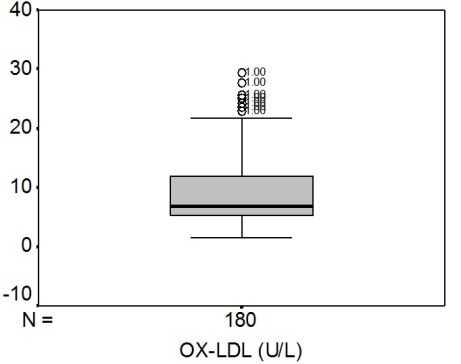
Box plot of OX-LDL levels in the serum of CAD study patients
Figure 5.
The correlation between oxidized low-density lipoprotein (Ox-LDL) concentrations and CAD score in CAD patients (p>0. 9)
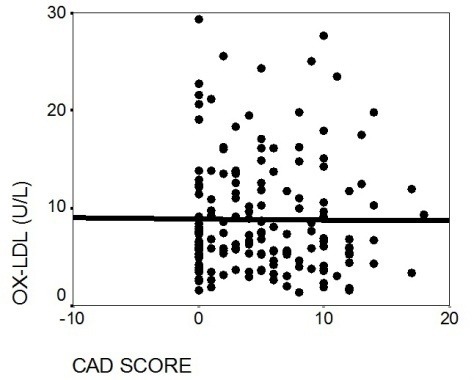
Figure 2.
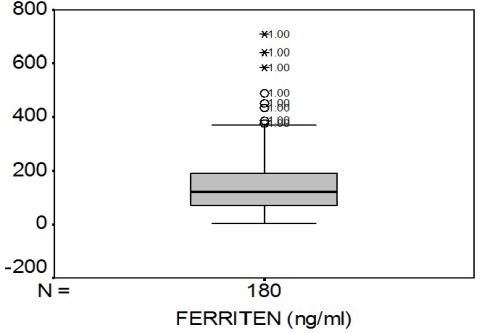
Box plot of Ferritin levels in the serum of CAD study patients
Figure 3.
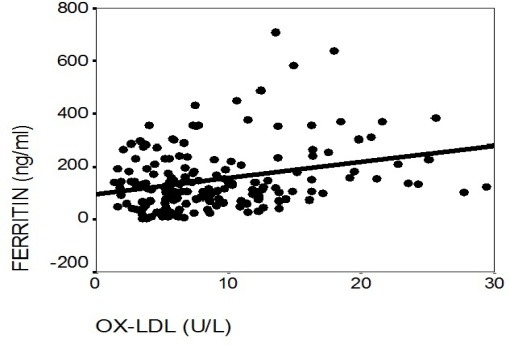
Serum concentrations of oxidized low-density lipoprotein (Ox-LDL) versus Ferritin levels in the CAD patients. There was a direct linear correlation between the oxidized LDL and Ferritin levels in the study group (r=0.24, p=0.001).
Figure 4.
The correlation between Ferritin concentrations and CAD score in CAD patients (p=0.005, r=0.208)
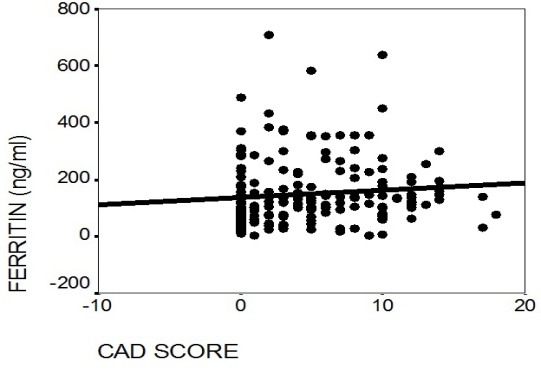
Discussion
Oxidation of LDL is believed to play an important role in the development of atherosclerosis. Lipid peroxidation can be induced by the highly toxic free radicals such as hydroxide and superoxide anions formed by Iron. The role of oxidatively modified LDL in the development of CAD is proven in vitro and animal studies.18 Antibodies against epitopes of oxidized LDL recognize materials in atherosclerotic lesions of rabbits and humans but not in healthy arteries.19,20
Antioxidants protect fatty acids in LDL particle against free radicals i.e. the richer in antioxidants an LDL particle, the more resistant to oxidation and of longer lag phase during the oxidation process.21 OX-LDL, an indicator of oxidative phases, is known as an initiator and accelerator of atherosclerosis. In the current study, we found a significant correlation between the CAD and Ferritin levels which is consistent with some other studies.19-22 Furthermore, a significant correlation was observed between the severity of CAD and the oxidized LDL in CAD Patients. However, some investigators have found no association between the Ox-LDL and CAD.21,22 The lack of association in these studies may be attributable to patient selection, methodological issues such as differences in antioxidant and vitamin concentrations. Iron has been suggested as an atherogenic agent mainly because of its capacity to initiate severe oxidative stress, which is supported by some epidemiologic23 and experimental24 studies. Our findings on the correlation between Ferritin concentrations and the oxidized LDL may support a role for body iron in promoting oxidation of LDL in CAD patients.
Conclusion
Our study showed that Ferritin levels in the CAD patients and in the control group were 337+280.3 and 120.6±100.2 respectively (P < 0.01). Therefore, increased Ferritin levels might represent an additional risk factor for atheromatic plaque formation and subsequent CAD development.
Footnotes
Ethical issues: The local ethics committee of Tabriz University of Medical Sciences approved the study and all patients signed informed consent.
Conflict of interests: The authors declare no conflicts of interest
References
- 1.Weisse AB. Cardiac surgery: a century of progress. Tex Heart Inst J . 2011; 38:486–90. [PMC free article] [PubMed] [Google Scholar]
- 2.Burgos JD, Munoz OC, Mukherjee D. Emergency intervention for unprotected left main coronary artery stenosis: case report and review of the literature. Hellenic J Cardiol . 2011; 52:545–8. [PubMed] [Google Scholar]
- 3.Thomas AC, Knapman PA, Krikler DM, Davies MJ. Community study of the causes of natural sudden death. BMJ . 1988; 297:1453–6. doi: 10.1136/bmj.297.6661.1453. [DOI] [PMC free article] [PubMed] [Google Scholar]
- 4.Rosamond W, Flegal K, Friday G, Furie K, Go A, Greenlund K. et al. Heart disease and stroke statistics-2007 update: a report from the American Heart Association Statistics Committee and Stroke Statistics Subcommittee. Circulation . 2007; 115:e69–71. doi: 10.1161/CIRCULATIONAHA.106.179918. [DOI] [PubMed] [Google Scholar]
- 5.Troisi A. Cholesterol in coronary heart disease and psychiatric disorders: same or opposite effects on morbidity risk? Neurosci Biobehav Rev . 2009; 33:125–32. doi: 10.1016/j.neubiorev.2008.09.003. [DOI] [PubMed] [Google Scholar]
- 6.Buonocore G, Perrone S, Tataranno ML. Oxygen toxicity: chemistry and biology of reactive oxygen species. Semin Fetal Neonatal Med . 2010; 15:186–90. doi: 10.1016/j.siny.2010.04.003. [DOI] [PubMed] [Google Scholar]
- 7.Itabe H. Oxidative modification of LDL: its pathological role in atherosclerosis. Clin Rev Allergy Immunol . 2009; 37:4–11. doi: 10.1007/s12016-008-8095-9. [DOI] [PubMed] [Google Scholar]
- 8.Steinberg D, Witztum JL. Lipoproteins and atherogenesis: current concepts. JAMA . 1990; 264:3047–52. [PubMed] [Google Scholar]
- 9.Gounopoulos P, Merki E, Hansen LF, Choi SH, Tsimikas S. Antibodies to oxidized low density lipoprotein: epidemiological studies and potential clinical applications in cardiovascular disease. Minerva Cardioangiol . 2007; 55:821–37. [PubMed] [Google Scholar]
- 10.Xavier HT, Abdalla DS, Martinez TL, Ramires JA, Gagliardi AR. Effects of oxidized LDL on in vitro proliferation and spontaneous motility of human coronary artery endothelial cells. Arq Bras Cardiol . 2004; 83:493–7. doi: 10.1590/s0066-782x2004001800007. [DOI] [PubMed] [Google Scholar]
- 11.Sugiyama S, Okada Y, Sukhova GK, Virmani R, Heinecke JW, Libby P. Macrophage myeloperoxidase regulation by granulocyte macrophage colony - stimulating factor in human atherosclerosis and implications in acute coronary syndromes. Am J Pathol . 2001; 158:879–91. doi: 10.1016/S0002-9440(10)64036-9. [DOI] [PMC free article] [PubMed] [Google Scholar]
- 12.Tuomainen TP, Punnonen K, Nyyssonen K, Salonen JT. Association between body iron stores and the risk of acute myocardial infarction in men. Circulation . 1998;97:1461–6. doi: 10.1161/01.cir.97.15.1461. [DOI] [PubMed] [Google Scholar]
- 13.Tuomainen TP, Diczfalusy U, Kaikkonen J, Nyyssonen K, Salonen JT. Serum ferritin concentration is associated with plasma levels of cholesterol oxidation products in man. Free Radic Biol Med . 2003; 35:922–8. doi: 10.1016/s0891-5849(03)00433-7. [DOI] [PubMed] [Google Scholar]
- 14.Moore M, Folsom AR, Barnes RW, Eckfeldt JH. No association between serum ferritin and asymptomatic carotid atherosclerosis. The Atherosclerosis Risk in Communities (ARIC) study. Am J Epidemiol . 1995; 141:719–23. doi: 10.1093/oxfordjournals.aje.a117493. [DOI] [PubMed] [Google Scholar]
- 15.Reunanen A, Takkunen H, Knekt P, Seppanen R, Aromaa A. Body iron stores, dietary iron intake and coronary heart disease mortality. J Intern Med . 1995; 238:223–30. doi: 10.1111/j.1365-2796.1995.tb00926.x. [DOI] [PubMed] [Google Scholar]
- 16.Baykan M, Celik U, Orem A, Malkoc M, Erdol C, Baykan EC. et al. Iron status and its relationship with lipid peroxidation in patients with acute myocardial infarction. Acta Cardiol . 2001; 56:277–81. doi: 10.2143/AC.56.5.2005687. [DOI] [PubMed] [Google Scholar]
- 17.Silvia WD, Biswas S, Uthappa S, Shetty P. Ferritin, a potent threat for acute myocardial infarction? J Assoc Physicians India. 2003; 51:947–50. [PubMed] [Google Scholar]
- 18.Navab M, Fogelman AM, Berliner JA, Territo MC, Demer LL, Frank JS. et al. Pathogenesis of atherosclerosis. Am J Cardiol . 1995; 76:18C–23C. doi: 10.1016/s0002-9149(99)80466-4. [DOI] [PubMed] [Google Scholar]
- 19.Haberland ME, Fong D, Cheng L. Malondialdehyde-altered protein occurs in atheroma of Watanabe heritable hyperlipidemicrabbits. Science . 1988; 241:215–8. doi: 10.1126/science.2455346. [DOI] [PubMed] [Google Scholar]
- 20.Palinski W, Rosenfeld ME, Yla-Herttuala S, Gurtner GC, Socher SS, Butler SW. et al. Low density lipoprotein undergoes oxidative modification in vivo. Proc Natl Acad Sci U S A . 1989; 86:1372–6. doi: 10.1073/pnas.86.4.1372. [DOI] [PMC free article] [PubMed] [Google Scholar]
- 21.Iribarren C, Folsom AR, Jacobs DR Jr, Gross MD, Belcher JD, Eckfeldt JH. Association of serum vitamin levels, LDL susceptibility to oxidation, and autoantibodies against MDA-LDL with carotid atherosclerosis. A case-control study.The ARIC Study Investigators Atherosclerosis Risk in Communities. Arterioscler Thromb Vasc Biol . 1997; 17:1171–7. doi: 10.1161/01.atv.17.6.1171. [DOI] [PubMed] [Google Scholar]
- 22.Halevy D, Thiery J, Nagel D, Arnold S, Erdmann E, Hofling B. et al. Increased oxidation of LDL in patients with coronary artery disease is independent from dietary vitamins E and C. Arterioscler Thromb Vasc Biol . 1997;17:1432–7. doi: 10.1161/01.atv.17.7.1432. [DOI] [PubMed] [Google Scholar]
- 23.Salonen JT, Korpela H, Nyyssonen K, Porkkala E, Tuomainen TP, Belcher JD. et al. Lowering of body iron stores by blood letting and oxidation resistance of serum lipoproteins: a randomized crossover trial in male smokers. J Intern Med . 1995; 237:161–8. doi: 10.1111/j.1365-2796.1995.tb01156.x. [DOI] [PubMed] [Google Scholar]
- 24.Regnstrom J, Nilsson J, Moldeus P, Strom K, Bavenholm P, Tornvall P. et al. Inverse relation between the concentration of low-density-lipoprotein vitamin E and severity of coronary artery disease. Am J Clin Nutr . 1996;63:377–85. doi: 10.1093/ajcn/63.3.377. [DOI] [PubMed] [Google Scholar]


